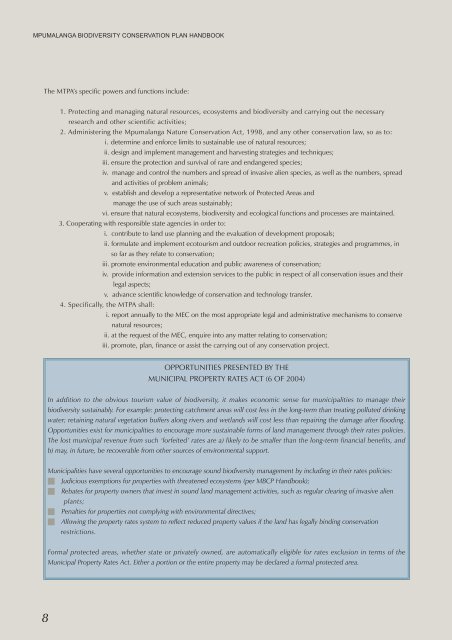Mpumalanga Biodiversity Conservation Plan Handbook - bgis-sanbi
Mpumalanga Biodiversity Conservation Plan Handbook - bgis-sanbi
Mpumalanga Biodiversity Conservation Plan Handbook - bgis-sanbi
You also want an ePaper? Increase the reach of your titles
YUMPU automatically turns print PDFs into web optimized ePapers that Google loves.
MPUMALANGA BIODIVERSITY CONSERVATION PLAN HANDBOOK<br />
The MTPA’s specific powers and functions include:<br />
8<br />
1. Protecting and managing natural resources, ecosystems and biodiversity and carrying out the necessary<br />
research and other scientific activities;<br />
2. Administering the <strong>Mpumalanga</strong> Nature <strong>Conservation</strong> Act, 1998, and any other conservation law, so as to:<br />
OPPORTUNITIES PRESENTED BY THE<br />
MUNICIPAL PROPERTY RATES ACT (6 OF 2004)<br />
In addition to the obvious tourism value of biodiversity, it makes economic sense for municipalities to manage their<br />
biodiversity sustainably. For example: protecting catchment areas will cost less in the long-term than treating polluted drinking<br />
water; retaining natural vegetation buffers along rivers and wetlands will cost less than repairing the damage after flooding.<br />
Opportunities exist for municipalities to encourage more sustainable forms of land management through their rates policies.<br />
The lost municipal revenue from such ‘forfeited’ rates are a) likely to be smaller than the long-term financial benefits, and<br />
b) may, in future, be recoverable from other sources of environmental support.<br />
Municipalities have several opportunities to encourage sound biodiversity management by including in their rates policies:<br />
Judicious exemptions for properties with threatened ecosystems (per MBCP <strong>Handbook</strong>);<br />
Rebates for property owners that invest in sound land management activities, such as regular clearing of invasive alien<br />
plants;<br />
Penalties for properties not complying with environmental directives;<br />
Allowing the property rates system to reflect reduced property values if the land has legally binding conservation<br />
restrictions.<br />
i. determine and enforce limits to sustainable use of natural resources;<br />
ii. design and implement management and harvesting strategies and techniques;<br />
iii. ensure the protection and survival of rare and endangered species;<br />
iv. manage and control the numbers and spread of invasive alien species, as well as the numbers, spread<br />
and activities of problem animals;<br />
v. establish and develop a representative network of Protected Areas and<br />
manage the use of such areas sustainably;<br />
vi. ensure that natural ecosystems, biodiversity and ecological functions and processes are maintained.<br />
3. Cooperating with responsible state agencies in order to:<br />
i. contribute to land use planning and the evaluation of development proposals;<br />
ii. formulate and implement ecotourism and outdoor recreation policies, strategies and programmes, in<br />
so far as they relate to conservation;<br />
iii. promote environmental education and public awareness of conservation;<br />
iv. provide information and extension services to the public in respect of all conservation issues and their<br />
legal aspects;<br />
v. advance scientific knowledge of conservation and technology transfer.<br />
4. Specifically, the MTPA shall:<br />
i. report annually to the MEC on the most appropriate legal and administrative mechanisms to conserve<br />
natural resources;<br />
ii. at the request of the MEC, enquire into any matter relating to conservation;<br />
iii. promote, plan, finance or assist the carrying out of any conservation project.<br />
Formal protected areas, whether state or privately owned, are automatically eligible for rates exclusion in terms of the<br />
Municipal Property Rates Act. Either a portion or the entire property may be declared a formal protected area.

















